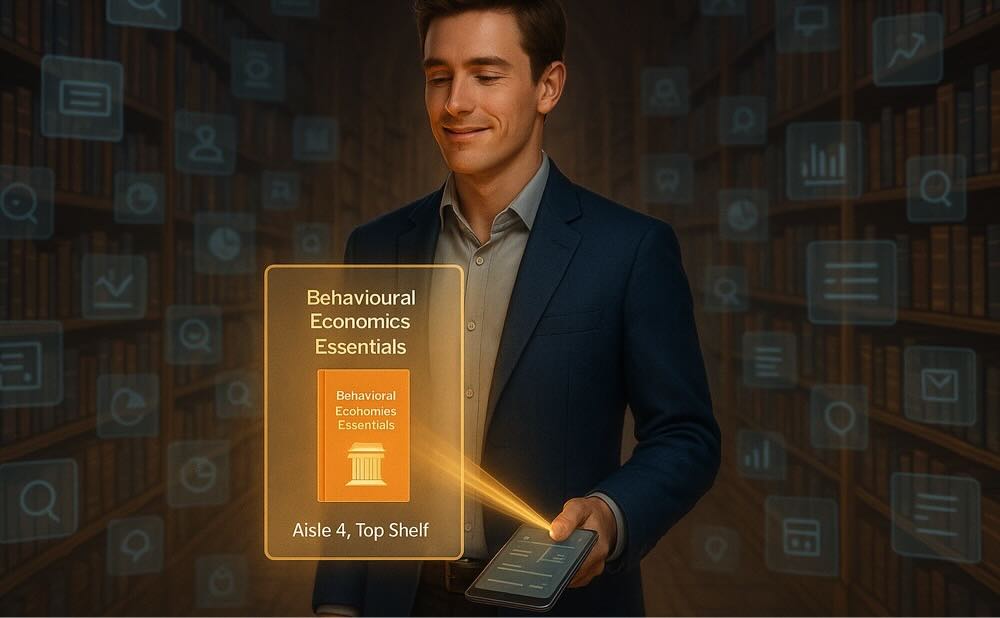Today’s users are bombarded with information and digital noise. In this environment, context isn’t a nice to have, it’s essential.
At the core of effective digital experiences is a concept every product leader should understand: the context window.
It’s a design principle that determines how your product communicates, adapts, and delivers value to the user in real time.
What Is a Context Window?
A context window is the information presented to a user at a specific moment in time, tailored to their current task, intent, and environment. It reflects where the user is in their journey and helps them make decisions without being overwhelmed by unnecessary details.
Think of GPS. It doesn’t show you the entire map, it highlights your next turn, dims distractions, and focuses on what’s immediately useful. That focused view is your context window. It gives you just enough information to guide your next move, without noise or distraction.
Imagine walking into a bookstore. Without help, you will be quickly lost in the aisles. But if the clerk knows you’re shopping for a gift for a 10-year-old, they can seamlessly guide you to the children’s section, and maybe even suggest a few bestsellers. That’s a context window in action. Filtered relevance saves you time, and builds trust.
Why Context Windows Matter
Context windows are more than design enhancements, they’re a product strategy tool. They simplify interactions and personalise engagement, both of which have a direct impact on business outcomes in three main ways.
1. Enhancing the User Experience
Every digital interaction is a decision point. Users need just enough information to act confidently. Context windows reduce cognitive overload by delivering the right details at the right time.
Take a ride-hailing app, such as Uber. When you open it, you don’t need the entire User Interface. You only need a map of nearby drivers, an ETA, and a “Request Ride” button. The fewer steps between intent and action, the better the experience for users, and higher the conversion rate. This idea is aligned with Hick’s Law, which states that the time it takes to make a decision will increase in proportion to the number choices you need to make.
Good context windows also employ anticipatory design, by predicting what users might need next and surfacing relevant options, pre-filling data fields, or suggesting next steps based on prior behavior. These cues make your product feel intuitive, responsive, and easier to use.
2. Eliminating Friction Points
Friction points are often not obvious, they won’t loudly announce themselves. They are often just the moments of quiet confusion users feel when they’re unsure what to do next. Context windows cut through that fog.
For example, an e-commerce website might automatically show a returning shopper some recently viewed items, estimated delivery times, and an active promo code. No digging through menus. No forgotten discounts at checkout. Just a smoother, faster path to purchase.
Removing friction points isn’t just more convenient for users, it converts better; leading to more customers, bigger purchases, and higher sales volumes.
3. Delivering Real-Time Personalization
Today’s users expect products to meet them where they are. Context windows allow products to respond dynamically to user behavior, timing, and even location.
In a financial app, a user reviewing recent spending might see a contextual nudge: “You’re $50 away from exceeding your monthly dining budget.” It’s timely and relevant, turning passive data into a proactive insight. These kind of micro-personalizations drive loyalty. Users feel understood. And that feeling, at scale, creates long-term engagement.
In a retail app, a shopper considering a pair of sneakers might see recommendations based on previous purchases, a selection of shoes in their size, and a countdown for same-day shipping. The elements are tailored to their individual preferences, and gently nudge them toward a decision.
Customer Impact
Well-designed context windows remove guesswork from the user experience. They build confidence by surfacing what matters most — when it matters.
Let’s look at two examples:
- Retail: A shopper considering a pair of sneakers sees recommendations based on previous purchases, a size guide, and a countdown for next-day shipping. Each element nudges them toward a decision without overwhelming them with options.
- Banking: A user setting a savings goal is shown recent deposits, projected timelines, and a friendly reminder of their spending habits. This reframes the experience from abstract financial planning to a tangible, motivating journey.
In both cases, the product doesn’t just show data — it tells a story. And the user moves forward.
Operational and Financial Impacts
Context windows don’t just improve user experience, they reduce cost and drive revenue. By enabling users to self-serve effectively, context windows reduce confusion, and thus the volume of support tickets. By guiding users through key moments, such as checkout, onboarding, and feature discovery, context windows reduce abandonment and increase conversion rates. Products that feel smart and personalized keep users coming back, which reduces churn and boosts customer lifetime value. According to McKinsey, companies using real-time personalization, often powered by contextual delivery, see increased revenue of up to 15%, and improved marketing efficiency of up to 30%.
The bottom line
Products that understand their users’ state, goals, and environment don’t just look better – they feel more intuitive to use, convert users with less effort, and retain more users over time, allowing them to scale more rapidly and generate higher sales revenues.
For product leaders, building with context windows means designing every moment with intentionality. It’s about meeting users not just where they are in your app, but where they are in their lives.
Whether you’re refining a mature product or launching a new one, always be asking, “What does the user need to know right now?”
That’s your context window.
Build from there.
Zuhair Imaduddin is a Senior Product Manager at Wells Fargo. He previously worked at JPMorgan Chase and graduated from Cornell University.
Image: DALL-E
🔴 Found these ideas useful?
Sharpen your edge
